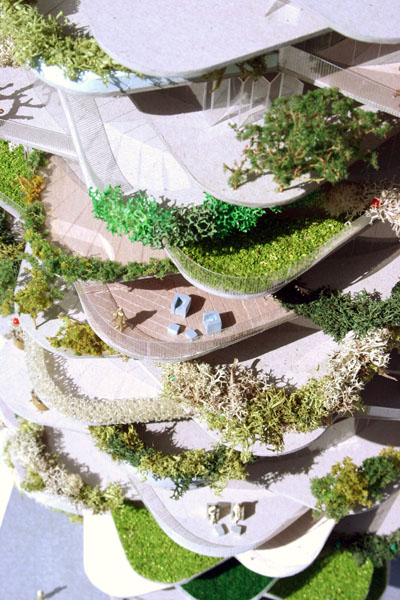
|
||
|
|
||
|
01 16
One Minute In The World’s Population Growth
Here is something you might enjoy. A while back I wanted to develop a graphical way to understand how quickly the world’s great cities were growing. This little flash-based tool illustrates in real time - in one minute - city population growth. You will note that some of the population icons are disappearing. That represents net population loss for those places. There is a bigger version available if anyone wants it. Just let CKF know.
12 20
Ontario Awarded For Anti-Sprawl Planning
 The American Planning Association awarded Ontario for its commitment to reduce urban sprawl. Why were we awarded this honour? Here is some history: Scaling Back OMB Powers a Good Start
The beginning of Toronto's long-needed urban design and architectural renaissance is at hand, if announced changes to the Ontario Municipal Board have the desired effect. Do not expect changes to happen soon, though -- unless city council proves itself up to its new powers. The OMB is a government body often loathed by municipalities and loved by developers. “People don’t always agree on how their communities should grow. When people can’t resolve their differences . . . the OMB provides a public forum for resolving disputes.” says the OMB web site With a dispute resolution mechanism skewed towards developer’s interests, many found the workings of the OMB to be overly complex. Neighbourhood groups complained that OMB members from Sudbury and London would overturn Toronto decisions in spite of having no first hand knowledge of the city’s communities. “The OMB is a planning casino where only developers win.” said provincial M.P.P. Mike Collie. For years, the OMB made city councilors apoplectic when it overturned local decisions. In time, developers learned where the real power lay. For example, after having his Sapphire Tower plan turned down by council a few weeks ago, Harry Stinson’s reaction was to go to the OMB because it would be, “more objective.” Affronts to city council aside, what precipitated the much-needed changes to the OMB’s powers announced by Minister Gerretsen? After all, changes to the OMB affect all municipalities in Ontario, not just Toronto. When development on Ontario’s environmentally critical Oak Ridge Moraine seemed out of control a few years ago, the Ontario Municipal Board made a decision that precipitated today’s announced erosion of its powers: it approved more moraine development in the face of well-informed opposition from almost every side of the social spectrum. With the support of nearly 90% of the public, the Liberals campaigned with a pledge to stop development on the moraine. In the end, the newly elected Premier halted construction for about a week before having to acknowledge there were limits to his powers. To the embarrassment of the new government, 6,000 additional houses went up on the moraine. This signaled to all Ontarians that Toronto’s sprawling suburbs threatened to permanently destroy environmentally crucial lands. The government answered with the sprawl stopping Green Belt Act. Reforms to the planning act and to the OMB have followed. Monday’s announced changes to the OMB return responsibility for municipal development to the hands of elected officials who know their communities. Are they ready to use this power or will myopic local interests rule our development choices? Don Schmidt of Diamond and Schmidt, a local architecture firm, says that council will have to take urban design and planning issues much more seriously than they have in the past when their decisions could be overturned. Paul Bedford, former chief planner of the city agrees saying returning development approval power to the city is long overdue and allows Toronto to have a much greater hand in its own future. “Councilors will have new freedom but they’ll have to know how to use it,” Bedford offers. “They’ll be limited by their creativity and their will.” Is our City Council ready for the task? Bedford thinks there is hope now that the mayor is making changes to the city’s governance structure. The Governing Toronto Advisory Panel recommended 11 changes that will provide mayor Miller with the tools he needs to lead while also strengthening community representation. The panel’s chair, Anne Buller, (...read more...)
12 19
Aviation’s Impact On Global Warming
 Image from www.air-and-space.com The Globe and Mail had a somewhat laudatory story this weekend on the early days of Porter Airlines based on Toronto's Island Airport. After much hand-wringing on the part of Mayor David Miller - a staunch opponent of the airport - it seems that Porter Airlines is now a fact of life on the waterfront. While the marketplace seems to think that having more convenient access to short-hop flights is a good thing, the downtown airport does not reduce the need for a faster, more environmentally efficient link from downtown to Pearson Airport in Malton. That a so-called "world class" city like Toronto has not figured this out says much about our ability to hold that designation into the 21st Century. Effective cities make this connection from the business district to the major airport with modern solutions. Why can't we? What does it matter? The Oil Drum web site has a sobering story today on the impact of aviation on global warming. Aircraft use about 1,800 million (1,800,000,000) barrels of oil per year moving people around the globe. Aviation is one of the fastest growing industry sectors in the world, growing at 2.4 times the rate of world GDP. The industry consumes over 5 million barrels of oil per day worldwide, almost one tenth of all the oil used for transportation. In the UK, according to the Department for Transport, the UK aviation industry is growing at approximately 5% per year while its fuel consumption is growing at 3% per year.
12 08
Sustainable Businesses: Steve Mann’s Hydraulophone
 Playing in the water: Even on cold Fall and Winter days, people are still drawn to play in the water to experience the soulful call of the hydraulophone, a sound sculpture and musical instrument that you play by putting your fingers on water jets. Hydraulophones used as landscape architecture give aquatic play a sophisticated and spiritually uplifting artistic element that draws people of all ages, not just children, to play in the water. By Steve Mann "Urban Beaches" ("urbeaches") are spaces that cross or challenge the traditional boundaries that have existed between professional civic life and the more playful elements of recreational life.
12 06
New Green Architecture
 One of the requirements of sustainable architecture is density: increased housing density reduces a community’s aggregate demand for energy. Now imagine the typical North American suburban home of the last generation. They boast a single dwelling on large plots of land surrounded by metres of pesticide-soaked, fresh-mown grass. To survive, they require vast infrastructures of roads, cars, sewers, electricity generation, gasoline production, natural gas pipelines, and more. Their waste pollutes our air, streams and lakes. They gobbled up millions of acres of Canada’s prime agricultural land and disrupt our aquifers. They are not sustainable. Unfortunately, those kinds of dwellings represent the Canadian dream for many of us. Who wants to live in a condo when it is possible to have people who do make that choice help subsidize—through their taxes—our unsustainable lifestyle. After all, if suburbanites were to pay the real costs of their infrastructure needs they could not afford to live out there on the edge of our cities. Our dreams may be changing. Architects are offering suburban-like dreams in urban form. Eco-friendly condominium designs that offer external green spaces are being built and our cities may never be the same. Here is a story on one such project:
 |

Contribute to the MESH Cities intelligent city database. Click here.
Read what people are saying about the environmental issues that impact us all
News about wind energy
News about green investing
Blog posts about electric cars
|
The best green news sources on the Net
Treehugger
Eco Worrier
Inhabitat
Lime
World Changing
|